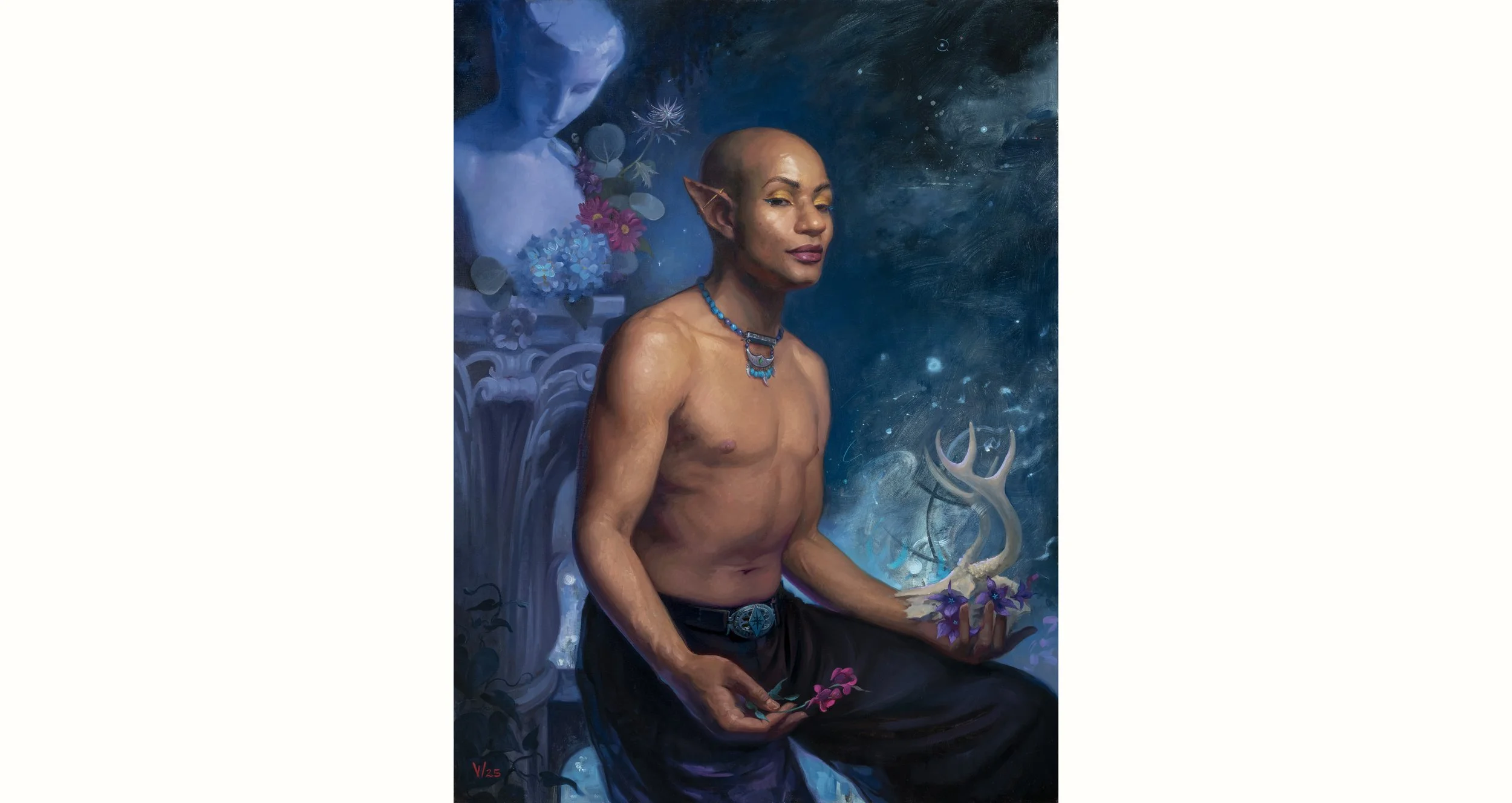Patricia Watwood, “Puck”, 2025, oil on linen, 40 x 30 in.
Patricia Watwood, The Fey Wild
November 6—december 6
Panel Discussion: Midsummer, Magic and Muses: November 22, 3:00pm
Artist Tour: November 29, 1:00pm–4:00pm
The Fey Wild, Patricia Watwood’s solo debut at Equity Gallery, comprises multi-figure narrative oil paintings, large scale drawings and a theatrical forest installation (extending out to the gallery courtyard) that quotes Victorian Fairy Paintings, Shakespeare, Fragonard’s Frick murals and the shadowy woods surrounding the artist’s rural Pennsylvania property.
“Puck is the Jester of the Fairy Court. He may perform service to Queen and King, but he may as well make mischief and upend the expected order. Here, I imagine Puck as a trans-faerie that weaves and warps the tapestry of the magical night.”
—Patricia Watwood
Christopher Wood writes in Fairies in Victorian Art that “Victorians desperately wanted to believe in fairies”. Prior to their appearance in nursery rhymes, fairies, along with ghosts and ghouls, offered an expressive outlet for the subconscious and an escape from the realty of a repressed, unromantic and materialistic age. We too yearn for enchantment. Disconnected and uninspired, our existence a somnambulant stroll (or a numbing scroll) wrought by a parallel and equally disorienting break from the past, in this instance a digital revolution, rather than the rapid industrialism that plagued the Victorians.
Shifting the locus of action from a corrupted world ruled by fear and loathing to the imagined world of enchantment has long been the artist’s métier for enacting cultural shifts. Like fairytale jaunts to grandma’s house, waking dreams and Patricia Watwood’s nocturnes, our inner lives play host to disorienting, and at times bizarre, happenings. Erratic and volatile, our minds and bodies fall prey to unruly passions, absurd infatuations and self-induced illusions. Yet, paradoxically, within this psychic space, where illusion and reality collide and mad imaginings run amuck, conflicts can be resolved and one can return, realigned and restored, to a new world view.
Hence, to reorder the outside world, we commence a journey within that traverses the fringe world of musings and prowling impossibilities conjured up in dreams, fairytales and the subconscious. Watwood, a classically trained figurative painter, maps this journey with multi-figure narrative oil paintings, large-scale drawings and a theatrical forest installation (extending out to the gallery courtyard) that quotes Fragonard’s Frick murals and the shadowy woods surrounding the artist’s rural Pennsylvania property. The resulting installation is a fantastical, disbelief-dispelling, queer world chock full of psychedelic viruses, gender-bending fawns, damsel/daemons, and gorgeous dudes all offering a respite from the fear-spawned rigidity of our sorely troubled world.
Alas, the caveat informing the success of this bait and switch caper hinges on the quality of the disruption and whether it’s defining qualities suffice to lure a receptive audience into questioning the status quo and considering the alternative views presented. Pictorial art, trafficking symbolic imagery that borrows heavily from dreams and memories (and thereby touching the subconscious), is the ideal communicator of novel, and at times radical, solutions to seeming insurmountable problems that evade head-on attacks fueled by the ego. Watwood, adept at creating irresistibly enticing tableaus, rises to the call. With The Fey Wild she presents imagery that reimagines Shakespeare’s daemon-infested midsummer forest as a theatrical conceit, a willful contrivance whereby pictorial logic, and any reference to the natural world, takes full flight in favor of a startling dream space where anything can happen—and does. And in this place of seeming chaos visited by homo sprites, trans fairies and archetypal changelings, Watwood leads her viewers to reconsider what is reality, what is illusion and what matters most.
Lastly, love and beauty, evinced both as content and form, and so combined creates a madness most poignant, threads a course through Watwood’s work. Fearless, and without a scent of irony, Watwood pushes right past the modernist tolerance for beauty with lascivious figures, starry-eyed portraits, jeweled toned backdrops and decorative line work. And that’s the most radical and refreshing thing you’ll see all year.
Patricia Watwood, “Prometheus”, oil on linen, 40 x 30 in.
Artist Statement
In this exhibition, my work is inspired by the playfulness of the Rococo, set in the faerie and imaginative world of the Fey realm of Titania, with a meta-narrative of theatrical trans queer magic and romantic extravagance. Installation elements invite viewers to move through the gallery spaces as they leave behind the world as we know it, and travel into the inner realm of the Faerie Court, a universe of matriarchy, queerness, mysterious beauty, tolerance, inclusion, sensuality and collaboration with spiritual forces.
The Fey Wild is a mythical realm, of which stories can be found throughout folklore and Olde Religion. In the theatre of Shakespeare, he casts the characters of Titania, Oberon, Puck and their faerie courtiers against the human world of the Athenians. This contrasts the universes of our societal norm as the land of day with its expected rationality, patriarchy and hierarchy, with the twilight of a magic liminal space in which down may be up, passion trumps politesse, frolick, pleasure, and the overthrow of the status quo can be predicted. In the Fey Wild, one can expect disorientation and anarchistic egalitarianism that values pleasure, mystery, the delights of entertainment, and the overthrow of business as usual. It is a land of contradictions, bright yet dark, beautiful yet deadly, and full of endless wonder. In this realm, Titania rules as Queen, eschewing power-over and prioritizing community, love, beauty, and freedom.
By offering a narrative tied to a mythic setting, the work creates an experience of visual art in a theatrical dimension that invites viewers to consider the place of the imagination to transform our ideas about the possibilities of the world into reality.


